Philippa Moore's Blog, page 9
September 20, 2020
the hardest part of this job

Image via
"You can do anything you want. I had forgotten that and I continue to forget and remember and forget and remember that I am free. That is the hardest part of this job." - Miranda July
seeds of spring
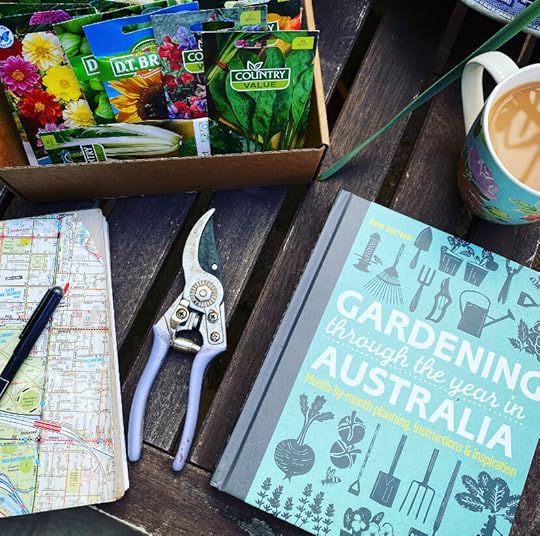
It is officially spring here now, which means it’s time to start planting my garden again!
Over the last 18 months I’ve had to relearn Tasmanian seasons, soils and planting calendars - it shouldn’t have surprised me that crops I had great success with in London were not as good here but, equally, things that failed miserably in London grow beautifully here! In London with only a little garden, I found I didn’t have to be as methodical or organised. Here, I have to study the sun, prepare soil and get things in the ground within a certain window of time if they’re going to reach their full potential.
Growing things has become a great passion of mine. Books take years to come to fruition, but gardening can give you gratifying results from your efforts in mere months. Though, of course, you have to play the long game with gardening as well. The very act reminds me that if I plant seeds and tend them with care, the end result can be something to be very proud of.
But equally, sometimes things won’t go to plan, despite all your careful planning and reading and tending. Perhaps the weather will be bad or the caterpillars will swarm in biblical proportions over your kale and cabbages, and there won’t be much you can do about it but learn from it and try again.
When I was a child I never used to understand why my parents were such keen gardeners but I do now. It’s meditative, it’s physical (so important when you spend so much time in your head and/or sitting down), it’s rewarding, and you’re creating something beautiful.
Most of all, gardening has taught me so much about life. That it’s better when you work in harmony with nature. That you can plan and invest time, money and energy in having a garden that makes you proud and happy, and should luck be on your side, fantastic. But ultimately, you have to relinquish control and let things be what they are.
When the Stay At Home order was in full force here in March, April and May, it was deeply comforting to be able to walk a few metres outside to my garden and pick vegetables for our meals rather than have to face the supermarket. COVID or no COVID, there’s nothing better than creating a meal where all the ingredients have been grown by your own hand.
I am looking forward to an abundant spring, summer and autumn, regardless of what’s going on outside of my own backyard!
September 18, 2020
a little nostalgia

I realised this morning that today was the day back in 2005 that I created a blogger account, selected this cutesy pink colour scheme and wrote my first ever blog post. I had absolutely no idea what I was doing. That small action changed my life forever, in numerous ways.
And that means I have now been writing online for fifteen years!
I deleted my first blog a long, long time ago - but this morning I put the URL into an internet “time machine” to see if it brought it up … and it did (see screenshot above). Let that sink in, even if you deleted your website in 2007, it’s very likely that bots have crawled it and it’s saved somewhere!! Gosh, hasn’t web design come a long way since then? My first template was an SEO nightmare!
It’s really quite mind-blowing how much life has changed since that day. The 24-year-old girl who started that blog in 2005 was blissfully naive and had no idea what was coming, how hard her crash landing would be, how much courage she really had, and all the amazing experiences and people that were waiting for her.
But as she began to write and bare her soul to the world through this tiny little corner of the internet, somehow she could feel the reassuring hand of her future self on her shoulder.
September 13, 2020
tinned tomato risotto
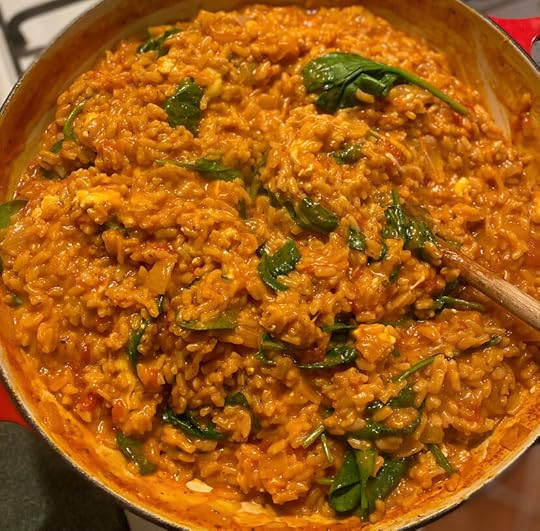
Super comforting, nourishing, delicious and on the table in less than half an hour. What more could you want from a bowl of food, I ask you?
If you have arborio rice and a tin of tomatoes in the pantry, you can make this. And once you make it, I’m sure you’ll make it again and again!
You can, of course, use fresh tomatoes in place of tinned if you prefer and have them handy, but personally I find the slightly concentrated flavour of the tinned ones adds so much to the richness of the dish - and evokes the canned tomato soup flavour of childhood that many of us find very comforting. In these strange times, comfort is something to prioritise, not just in cooking.
You don’t need to add cheese if you don’t have any or prefer not to, but little cherry bocconcini are a particularly good addition - a forkful of creamy, sweet and tangy rice combined with those delicious strings of melted mozzarella, it’s like a margarita pizza in a bowl!
Tinned tomato risottoServes 4 moderate appetites or 2 extremely hungry bushwalkers
Olive oil
1 onion, finely chopped
1 large garlic clove, finely chopped
A few large silverbeet stalks, chopped (reserve the leaves for later) [this is optional, I grow silverbeet so put it in everything]
2-3 teaspoons dried oregano and basil, or to taste
50g butter
2 cups arborio or carnaroli rice
Splash of red wine, white wine or cooking sherry (or even red wine vinegar at a push)
2 tablespoons tomato paste
1 x 420g tin peeled plum tomatoes
1 litre boiling hot vegetable stock, plus a little extra
Spinach leaves, silverbeet leaves, fresh basil or oregano, to serve
A handful of cherry bocconcini (or substitute any other cheese you have, ricotta is very nice)
A handful of grated Parmesan cheese, to serve
Salt and black pepper, to taste
Fill your kettle and put it on to boil.
Get a large saute pan - I use my Le Creuset shallow casserole dish, but I have made this kind of risotto in a stockpot before, just make sure you have a lid - and add a splash of olive oil and place over a medium heat. Add the onion, garlic and chopped silverbeet stalks and cook until they start to soften.
Add your dried herbs and butter, and once the butter has melted but not coloured, add the rice and turn up the heat. Get the rice coated in the butter. Keep an eye on everything so it doesn’t start to stick or burn but it’s crucial to have the heat high at this point.
Add a generous splash of wine and the pan should sizzle! Stir quickly to coat everything. Add the tomato paste and tin of tomatoes. You can use whatever tinned tomatoes you have but I prefer the whole plum ones because they have great flavour. You can break the tomatoes down with your wooden spoon as you stir.
Get your stock made and then pour a splash into the pan, as you would normally with a risotto. Stir well. Then add the rest of the boiling hot stock, maybe even rinse out the tomato can with boiling water and add that too. You can always cook excess liquid off, but a risotto with insufficient liquid is a disaster!
Stir well, ensure the rice and tomato mixture is entirely covered by hot stock and liquid. Bring to the boil. Add salt and pepper if you like (I often do it here and at the end). Stir one more time to ensure nothing is caught at the bottom and then reduce the heat to a simmer, put the lid on and set your timer for 20 minutes.
This is very unlike the traditional method of making risotto, but once you’ve successfully mastered cooking it this way, you’ll never go back!
You can come back and stir it occasionally if you like, but otherwise after 20 minutes it will be pretty much there. The liquid should have reduced (you still want some liquid, you don’t want it completely dry) and the rice should be tender.
Turn the heat off. Add your green leaves and fresh herbs and any cheese you’re using, and stir through to melt the cheese and wilt the leaves. You can leave it with the lid on again for a few minutes to do this if you like.
Taste and season, serve in wide bowls with a scattering of Parmesan on top and a few basil leaves if you have them.
Deeply satisfying and delicious, this risotto (or variation) thereof makes an appearance at our table at least once a week. I hope you love it as much as we do!
August 27, 2020
healthy no-waste veggie burgers
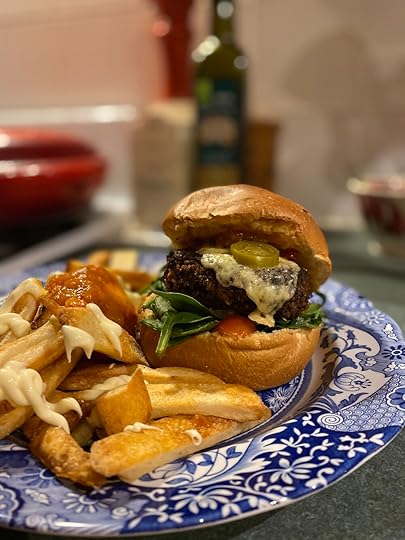
I had a favourite brand of vegetarian burgers that I’ve been buying since we moved here - Woolworths’ Macro Vegetable and Chickpea burgers. $4 for a pack of four. A delicious bargain.
Since the COVID-19 chaos kicked off, these burgers have been nowhere to be seen in any of Hobart’s Woolworths. They may well still be available on the mainland - perhaps Tasmania simply doesn’t have the vegetarian population to justify shipping them down! And let’s face it, for the last five months, I’ve just been grateful that most of my preferred items have been available. Veggie burgers are easy enough to make from scratch!
In constant pursuit of my no-waste policy, and Tom’s adoration of our “burger and chips night”, an alternative burger was created from leftover cooked brown rice, vegetables and a can of black beans. They are, I am not exaggerating, the *best* burger I have ever made at home. Add all the fixins, a pile of golden oven-cooked chips and you’ll wonder why you’d ever bother going out for dinner at all. Which, let’s face it, many people cannot at the moment. This burger is for all of you.
No-waste veggie burgersMakes at least 12, depending on size
350g leftover vegetables (I used frozen mixed vegetables defrosted in a little boiling water then drained)
500g leftover cooked rice
1 x 420g can black beans, drained
100g fresh breadcrumbs
3 tablespoons wholemeal plain flour
2 tablespoons garlic powder
Fresh herbs, as much as you like (I used basil, parsley, mint, rosemary and thyme)
Sea salt and freshly ground black pepper, to taste
It couldn’t be simpler. Whack everything in a food processor, blitz until the mixture is pureed and the consistency of mince. You shouldn’t need to add any liquid at all, but you can add a splash of water or the bean liquid if it’s too dry and not coming together.
Wet your hands slightly and scoop out handfuls of the mixture and shape into patties. I use my egg rings to get them a fairly uniform shape and size (just spray the insides with cooking spray first).
You can either grill them straight away (if so, I would dust lightly with a little flour, depending on how wet the mixture is) or do what I do and freeze them in a large container with a layer of baking paper between them. I got 14 out of this mixture - two we ate straight away and I froze the remaining 12.
I cook them from frozen in a super hot oven (about 220 C), with the chips. The first side gets 20 minutes, then I take them out of the oven, flip them over and put them back in for 15 minutes. For the last five minutes, I usually put some cheese on top to melt and put them back in the oven for five minutes, together with the brioche buns (which I’ve usually had defrosting most of the day) to warm up.
This method gives the burger a nice crunchy exterior but the inside remains moist. I haven’t tried them on a barbecue yet but summer is just around the corner! I will report back.
“All the fixins?” I usually ask Tom at this point.
“Of course,” he responds.
So our burger fixins are - mayo, whatever relish or chutney I have open (this week it was the fiery apricot chutney I made in February), mustard, sauerkraut, baby spinach or rocket (or any salad leaves), pickled tomatoes, pickled chillies and a bit of basil pesto if there’s any kicking about. All piled on top of the burger in a (storebought) brioche bun. Sounds like a strange mixture but it’s all very delicious!
Enjoy!
August 26, 2020
write every damn day
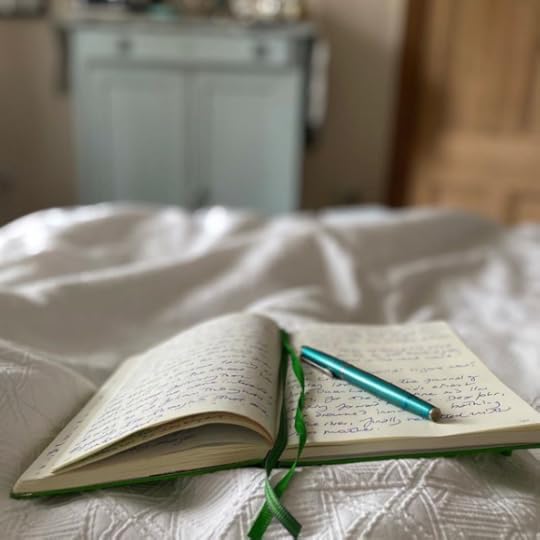
As of this morning, I have done Morning Pages for 250 days straight!
I’d say the most noticeable impact it’s had has been on my confidence. When you consistently show up for yourself and do the thing that matters most to you each day, I’ve found the inner critic, while still alive and well, doesn’t have as much ammunition.
The whole routine/ritual around Morning Pages is now my favourite part of the day. And I am not a morning person!
A follower on Instagram asked if I had any advice on getting started and my response was just that - to start. Just begin and keep going, even if you think what you’re writing is rubbish - it will be, that’s the whole point. But after a month or so you’ll find yourself coming up with new ideas because all the muck has been cleared out. Or you’ll feel differently about something you’ve been stuck on. So start, and then persevere. And create a nice ritual around it too, like making tea or coffee, or having your favourite music playing.
I meditate first - I’m still going on my daily habit there too (since 2 May 2017!) - and then I put my AirPods in and select my favourite writing music. Most days it’s Ludovico Einaudi but other days it will be Beethoven or Bach I want to hear. Anything gentle. Then I pick up the pen, turn to a blank page and write for three pages. Often Tom will bring a coffee in while I’m writing and thanks to the noise cancelling headphones and being in the zone, I will barely notice!
And once the pages are done, I am free to get on with my morning. My writing work later in the morning, or later that day, is always better for having cleared the decks first thing.
The next step, at some point, will be to go through the Morning Pages books and see what themes keep appearing, what words and images I repeat, what is clearly uppermost in my mind. They are the clues to where I might go next on this creative journey.
Do you do Morning Pages? Or do you have a morning creativity ritual?
July 1, 2020
eavan boland: the lost art of letter writing

Image by Bruno /Germany from Pixabay
THE LOST ART OF LETTER WRITING
The ratio of daylight to handwriting
Was the same as lacemaking to eyesight.
The paper was so thin it skinned air.
The hand was fire and the page tinder.
Everything burned away except the one
Place they singled out between fingers
Held over a letter pad they set aside
For the long evenings of their leave-takings,
Always asking after what they kept losing,
Always performing—even when a shadow
Fell across the page and they knew the answer
Was not forthcoming—the same action:
First the leaning down, the pen becoming
A staff to walk fields with as they vanished
Underfoot into memory. Then the letting up,
The lighter stroke, which brought back
Cranesbill and thistle, a bicycle wheel
Rusting: an iron circle hurting the grass
Again and the hedges veiled in hawthorn
Again just in time for the May Novenas
Recited in sweet air on a road leading
To another road, then another one, widening
To a motorway with four lanes, ending in
A new town on the edge of a city
They will never see. And if we say
An art is lost when it no longer knows
How to teach a sorrow to speak, come, see
The way we lost it: stacking letters in the attic,
Going downstairs so as not to listen to
The fields stirring at night as they became
Memory and in the morning as they became
Ink; what we did so as not to hear them
Whispering the only question they knew
By heart, the only one they learned from all
Those epistles of air and unreachable distance,
How to ask: is it still there?
- Eavan Boland
April 30, 2020
tomato, caper and mint spaghetti
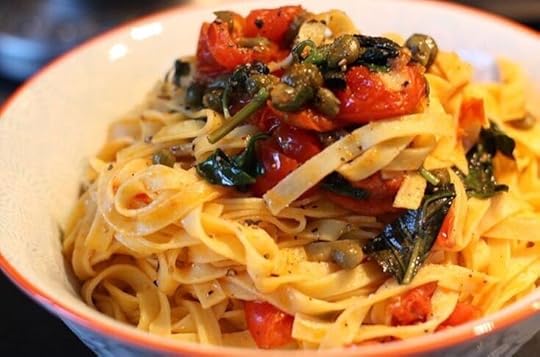
Tom and I were watching a Rick Stein show where he was in Sicily. He didn’t cook this dish but mentioned a pasta he’d once enjoyed in Palermo, simply made with tomatoes, capers and mint. I’ve never managed to find a recipe for it anywhere, but it sounded so delicious I simply had to give it a try. And it was as amazing as it sounded.
That was a few years ago now and this is still one of our most favourite pasta dishes. Sometimes I’ll just say “Rick’s pasta?” to Tom when it’s getting close to dinner time, and his eyes light up!
It’s best made with long pasta - in the picture I think I’ve used fresh tagliatelle, but I’m particularly partial to linguine. You can add chilli - I sometimes do - but this pasta doesn’t even need Parmesan, truth be told. The capers are punchy and acidic, the mint is fresh and savoury, the tomatoes are sweet. It’s just glorious.
I hope you like it as much as we do!
Tomato, caper and mint spaghettiEnough for 2, with room for dessert
250 g spaghetti (or any other long pasta)
Good quality extra virgin olive oil
2 garlic cloves, peeled but left whole
Roughly 250 g cherry tomatoes, or larger truss tomatoes, halved or quartered depending on size (use as much as you like, this is just a guide)
Roughly 5 tablespoons capers (from a jar) (and again, use as much as you like - we love capers so add about half the jar!)
1 small bunch fresh mint leaves, finely chopped
Salt and pepper
Put a stockpot of salted water on to boil and cook the pasta according to packet instructions or desired al dente-ness.
Get a large saute pan - I use my Le Creuset shallow casserole dish - and cover the base in olive oil, adding enough for the tomatoes to paddle in. Add the garlic cloves.
Place the pan on a medium heat and allow to heat slowly. Once you hear the garlic sizzling, carefully add the cherry tomatoes (I leave them whole, but you could halve them). Turn the heat down, put the lid on and allow the tomatoes to cook gently in the oil for about 10 minutes, roughly the same time it will take the pasta to cook. Check on them occasionally. You don’t want them to be mushy and breaking down too much, just soft.
You can remove the garlic at this stage if you prefer, but I usually leave it in. Add the capers to the tomatoes, and a bit of salt and pepper. You could also add a splash of white wine if you have any handy.
Once your pasta is ready, using tongs, carefully lift the cooked pasta out of the stockpot and into the tomato and caper pan. The water clinging to the pasta will help make a lovely sauce.
Once you have all your pasta in the tomato pan, turn up the heat slightly, add the chopped mint, and toss everything through with the tongs so that the pasta is completely coated in the tomatoes, capers, mint and oil. Everything should be beautifully combined. It shouldn’t be dry but if it is, add another splash of the pasta cooking water.
Season with salt and pepper to your taste.
Heap into waiting bowls and eat immediately - as if you’d want to do anything else!
I have made this with basil and parsley before when I only had a sad lone sprig of mint from my garden and it’s still delicious - but do make this with just mint at least once as it’s sublime. I just adore mint, it’s one of my favourite herbs and gives such a beautiful flavour to everything from salads and grilled vegetables to slices of grilled halloumi.
fig and ricotta cake
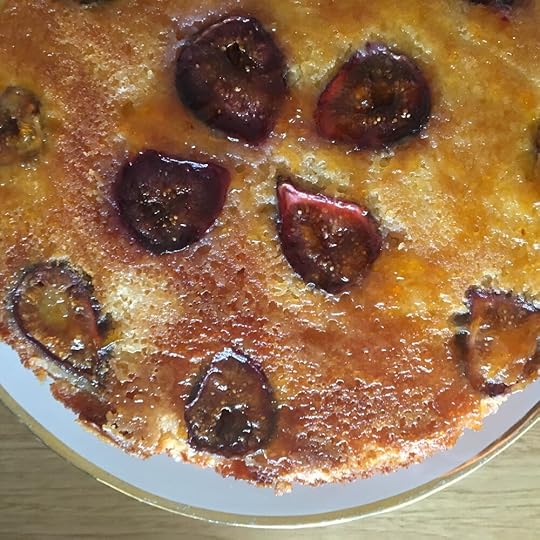
This autumn has been all about the quince, but last year it was all about the fig. There were a few figs getting jammier by the day on my parents’ tree and we needed to pick them before the possums got to them. I made a delightful pear and fig chutney, and this cake.
You can use any plain soft creamy cheese in place of the ricotta - I used half goats cheese and half ricotta, which worked splendidly.
I really loved this cake because it wasn’t too sweet and allowed the natural sweetness of the figs to shine through. My parents, who like things sweeter, weren’t that fussed - so by all means add more sugar if you have a similar palate!
Autumnal slightly savoury fig and ricotta cakeBased on a recipe in Books for Cooks Favourite Recipes 4, 5 and 6
2 tablespoons caster sugar
6 fresh ripe figs, stalks trimmed, cut in half
175 g unsalted butter
150 g caster sugar
1 teaspoon vanilla extract
200 g ricotta (or a combination of ricotta and soft goats cheese)
2 large eggs
175 g plain flour
1 tablespoon baking powder
A little apricot jam, for glazing
Preheat the oven to 180 C (fan-forced). Grease and line a 24cm springform cake tin. Butter the baking paper on the base of the tin and sprinkle with the 2 tablespoons of caster sugar. Arrange the halved figs, cut side down, over the sugar.
Beat the butter, sugar, vanilla and ricotta (or other cheese you’re using) together until creamy and fluffy. Beat in the eggs one at a time. Add the flour and baking powder and gently fold in.
Spread the batter carefully over the figs.
Bake in the oven until golden and a skewer inserted into the middle comes out clean - roughly 40-45 minutes, depending on the strength of your oven. Leave to cool completely in the tin.
To decorate, turn out the cake on to a plate or stand, fig side up. Melt the apricot jam over a low heat until soft and liquid, then brush over the top of the cake. The figs will glisten beautifully.
You can dust the top with icing sugar once you’ve glazed too, but I didn’t.
Cut into slices and enjoy with a hot cup of tea.
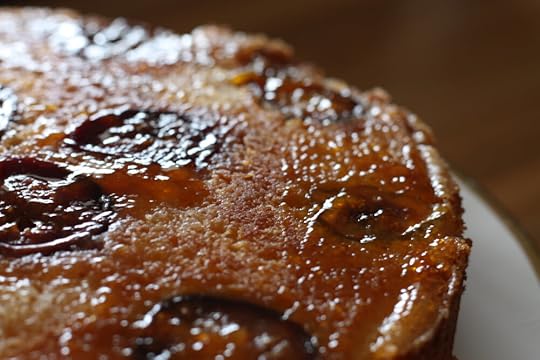
My figs were quite little! Hope yours are bigger.
April 27, 2020
some wonderful (and free) resources for writers

Image by Free-Photos from Pixabay
Are you finding it a bit hard to write at the moment? Me too.
Thank goodness for my morning routine of meditation followed by Morning Pages, which I had established well BC (Before Corona). It is my anchor. Even though I find it hard to concentrate for solid lengths of time right now, the habits I’ve formed over the past few years in starting my day are serving me well. My Morning Pages are now less a brain dump and more of a daily “life in these strange times” chronicle which are making for entertaining and often mind-boggling reading weeks later. It’s bizarre to see life changing so quickly as the journal fills up. I’m very glad I’m writing everything down. I might share some, at some point.
But how to stay motivated with my actual writing?
The internet is a mixed blessing, to put it annoyingly simply. It is a source of endless distraction and I have found myself losing hours and days to browsing and scrolling, my original purpose in going online long forgotten by the time I realise what I’m doing and how much time has passed. It is also a way to feel frustrated, horrified, angry and despairing for humanity - one only has to go on Twitter to understand why the world is burning.
But on the flip side, it’s also a goldmine of useful resources, particularly for writers and creative people, and I have found some incredibly helpful and inspiring posts, courses, websites and podcasts over the past 40-odd very strange days. Today, I thought I might share some of them with you.
Writing Right NowThis is a post specifically about academic writing in the time of COVID-19 but I found it very useful and applicable to my non-PhD work as well.
The key for me during these extraordinary times is that each person ought to be given space to reevaluate what they are able to do. Thinking that you should be able to carry on as usual or, worse, be more productive is to underestimate the effect of everything going on around you.
Writing Productivity for the Four Tendencies
Gretchen Rubin’s The Four Tendencies can be a very useful tool for figuring out how your motivation works (internal, external, both) in life and in your art. I think I’m an Upholder but when it comes to writing, maybe I am a Rebel! (side note: I just did the quiz again, I am a Rebel, full stop). This is a very useful post from Sarah with lots of ideas that feel very doable.
The Writer’s Room Podcast with Charlotte WoodThis is a wonderful podcast to get your mojo fired up again, or even just to entertain the idea of opening your document or picking up the pen again if you’ve been feeling stagnant. The standout episode so far for me is the interview with Jerry Salz. He reminded me so much of my old boss in London! Jerry’s brilliant article How To Be An Artist is a worthy addition to your bookmarks and self-motivational arsenal.
Originality did not conveniently die just in time for you and your generation to insist it no longer exists. You just have to find it.
Charlotte’s interview with Jerry is full of amazing truth bombs like this.
I would also recommend A Mind of One’s Own, which is Charlotte Wood’s podcast from a few years ago, designed for writers with lots of tips on how to enrich your creating life.
Tim Clare’s 100 Day Writing ChallengeI once saw Tim perform at a slam evening in London, about 11 years ago now. Scroobius Pip performed one of my favourites of his poems, and Tim was also awesome, reading from his memoir We Can’t All Be Astronauts (which I read later and really enjoyed). He’s a refreshingly honest, bold and witty writer. This is a writing course that, as the name suggests, is a daily prompt for 100 days, delivered by podcast (with an accompanying transcript). Tim is a genuinely enthusiastic course leader and when he says “I’m proud of you, well done for getting this far” each day, I really believe him (thanks Tim!). Already it has encouraged me to take a small idea and just run with it, and it has brought a lot of joy back into writing for me. Highly recommended.
Writing with DevEverything sucks until it’s finished, and most things still fucking suck. The bottom line is, we don’t write to be praised or paid or get a profile or win prizes. We write because it makes us feel better.
Another writing course delivered virtually with the Australian writer and comedian Catherine Deveny. You can watch her excellent, upbeat and irreverent writing course videos via Facebook or Youtube. She’s a great cheerleader, particularly when it comes to trusting and believing in yourself: “You have to become your own self-saucing pudding.” (a lovely image there).
Each lesson has heaps of prompts and writing exercises, which Dev does with you in real time. There’s a wealth of material and she has very kindly made it free but you can donate an amount of your choice, or buy her book and writing poster, if you’re able to.
Helen’s Word Stay Home Writing RetreatOne of my PhD supervisors got me on to this. While it has an academic flavour, I’d highly recommend it to any writer. I’ve only just started it but so far it’s all about not only making time to write but developing robust strategies to maintain your writing practice. Helen also encourages you to write by hand to give your eyes a break from a screen and your fingers a break from the keyboard, which I am all for. I’m about to go and watch today’s “after writing” video now!
I’m doing my best not to be hard on myself for not being a productivity machine - the standards of the world we lived in two months ago no longer apply, really, because that world is gone. For now, at least. As Helen says, setting simple and attainable goals is probably most helpful.
What about you?I’d love to know if you’ve found any helpful resources like these to keep you motivated and interested during this time.
Philippa Moore's Blog
- Philippa Moore's profile
- 7 followers



